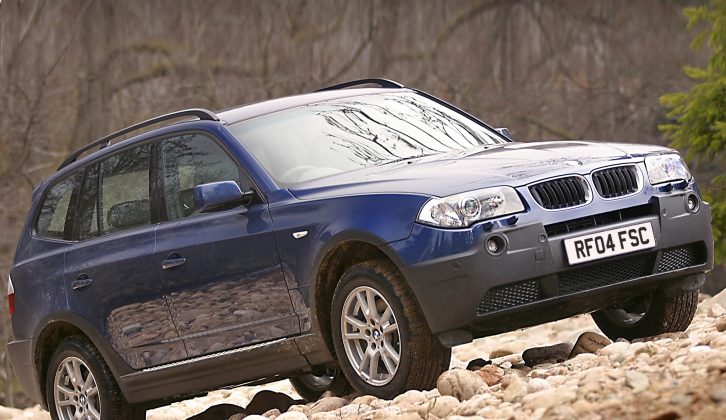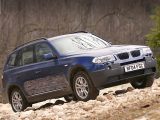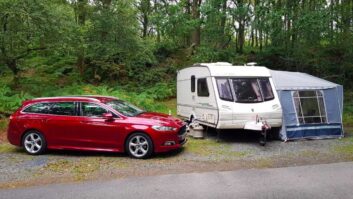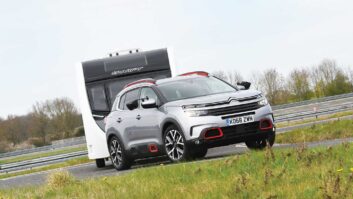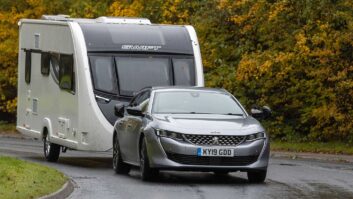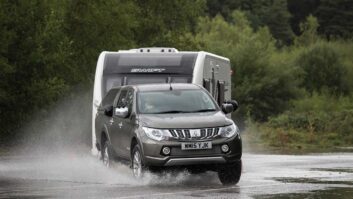Following the success of the X5, BMW launched the X3 four years later as a more affordable alternative. Bizarrely, it was then immediately criticised by the motoring press for looking, and being, cheaper than the X5.
Based, as its name suggests, on 3-Series running gear, the X3 is actually the same height and almost as long as the X5, but is close to a foot narrower. That not only makes the X3 more manoeuvrable and easy to park, but does away with the steroid-pumped aggression that makes the BMW X5 look like it’s always about to punch somebody.
In fact, the X3 is best thought of not as an off-roader but more as a highly capable and very well built four-wheel-drive estate car. It is often criticised for its hard ride, but that proves a positive bonus when you hitch a caravan on the back.
Model history
The BMW X3 was launched in May 2004 with all models getting ‘intelligent’ four-wheel drive, Dynamic Stability Control and Hill Descent Control as standard. Trailer Stability Control was optional and is worth looking out for on the kit list. The initial engine choice was limited to two petrol straight-sixes: a 189bhp 2.5-litre and a 227bhp 3.0-litre.
In September 2004 the four engines were joined by a 2.0-litre diesel with 147bhp and a useful 243lb ft of torque, and a very decent 39mpg. A year later, an entry-level 2.0i four-cylinder petrol model was added with 147bhp but a paltry 148lb ft torque. However, more to the point, this was also the launch point for the 3.0-litre diesel, boasting 214bhp, 369lb ft torque and 35mpg – now we’re talking.
The range was overhauled in September 2006 with a more luxurious interior and improvements across the engine range. Wisely, the 2.0i was dropped, but the other petrol engines gained in both power and fuel efficiency. The 2.5 now produced 214bhp and the 3.0-litre 268bhp, and both offered close to 30mpg.
Then there was the new daddy of the range, the 3.0sd. Offered alongside the standard 3.0d, this was tweaked to produce 281bhp and a monster 428lb ft of torque, yet could return 36mpg – form an orderly queue everyone. In some later applications this engine was also referred to as a 3.5d, but that’s misleading as it remains a 3.0-litre.
There were two more engine changes, both to the 2.0d. In September 2007 the unit was boosted to 177bhp and 258lb ft torque, with economy up by 4mpg. Then in May 2009 BMW introduced another entry-level model called the 18d, though it was actually a 2.0-litre unit detuned to 140bhp and good for 45mpg.
You could only have a six-speed manual gearbox with the low-powered 2.0 cars, and the petrol 3.0i and 3.0sd were auto only (five-speed at first, then six-speed from 2006). The remainder got the choice of manual or auto.
Trouble spots
The main issue with 2004-2010 BMW X3s is turbo failure on the diesel engines, particularly the 2.0d, often at or even before 60,000 miles. The cause appears to be impatient owners not cooling the turbo by letting their cars idle for a while before switching off, as instructed in the manual. This causes carbonisation of the oil in the turbo bearing and its oil feed pipe, which becomes blocked leading to oil starvation.
It costs around £2000 to have a new turbo fitted, and the oil feed pipe must be replaced at the same time or the new unit will quickly fail, too. So if the turbo has been replaced, check the itemised bill for details. If it hasn’t been replaced, take out a warranty to cover failure as you cannot be certain how the car has been treated by past owners.
It is also wise to do oil changes every 10,000 miles and not only when the service indicator says. And on the test drive it is important to listen for a clicking noise from the transmission transfer box just after the engine is turned off. If you can hear it then teeth have stripped off a plastic gear wheel in the box’s actuator. This happens over time anyway, but much more quickly if there is any disparity between tyre sizes. And a new actuator will cost you close to £900.
Ideally, an X3 needs tyres of the same size, make and degree of wear on each corner, so check that too, and factor any differences and need for replacement into the deal.
As yet no corrosion issues have become apparent in the X3, with the exception of the roof rails of all things. Check those as there’s potential for rust to spread to the roof itself.
Verdict
The BMW X3 is not only an excellent tow car alternative to a Range Rover, it is also, in our book at least, preferable to its big brother, the X5. The market agrees, too, and the X3 is proving better at holding its value, to the point where early examples of both with the same engine are now a similar price.
So the BMW X3 is no bargain, but on the other hand you’ll never feel the need to apologise for owning one.
If you’re in the market, the model we’d go for is the 3.0sd. The regular 3.0d is more than adequate, but just knowing that this beast exists drops it back into second place. The 3.0sd has the kind of power that makes whatever it pulls behind it irrelevant. And it even gets slightly better mpg.
However, we’d avoid the 2.0i. There’s simply too little grunt on offer for a car that weighs nearly 1.7 tonnes, which is why this lowly petrol model has a 100-400kg lower towing limit than the other models. Even that’s being generous – you would dread hills.
What you need to know
How much is a towball? Well, according to quotes we got from PF Jones, a Witter fixed towbar costs £120.91 and a Westfalia detachable towbar £155.00, fitting extra.
And what about servicing? An interim service will cost £220, a full service will be £275, for all engine variants, according to Servicing Stop.
Here are some useful figures (for a 2008 BMW X3 3.0d):
- Kerbweight 1805kg
- Towing limit 2000kg
- Towball limit 80kg
- 85% match 1534kg
The main issue is turbo failure on the diesel engines, particularly the 2.0d
